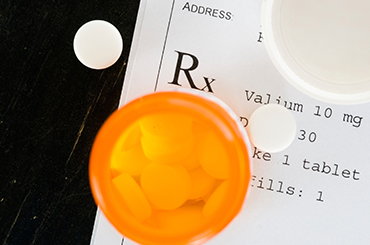- Signs and Symptoms of Valium Abuse
- What are the Effects of Valium Abuse?
- Combining Valium with other Substances
- How are Valium Use Disorders Diagnosed?
- Who is at Risk for Valium Addiction?
- When to Seek Help from Recovery Programs
- Help for Addicted Friends and Family
- Rehab and Treatment Options
- Teen Valium Abuse and Addiction
What is Valium Abuse?
- Prolonged use of Valium, a central nervous system (CNS) depressant, leads to an increase in tolerance, causing a user to take more, which increases their chance of addiction.
- Someone with a history of alcohol or drug abuse may be at risk for addiction to Valium.
According to the American Psychiatric Association (APA), Valium, the brand name for diazepam, is classified as a benzodiazepine. Benzodiazepines are a class of drugs that lead to sedating, hypnotic (sleep-inducing) and anxiolytic (anti-anxiety) effects.
Therefore, a Valium user would fall under the APA's Diagnostic and Statistical Manual of Mental Disorders, fifth edition (DSM-5) Sedative, Hypnotic or Anxiolytic Use Disorder diagnosis. This is a condition characterized by:
- The harmful consequences of repeated use of Valium.
- A pattern of compulsive use of Valium.
- (Sometimes) physiological dependence on Valium.
Signs and Symptoms of Valium Abuse
Someone using Valium may:
- Appear calm or drowsy with slurred speech.
- Be less capable of reacting to physically or emotionally stressful situations.
- Seem uncoordinated, but this effect is diminished as tolerance builds up.
Immediate effects of Valium use include:
- Relaxation.
- Euphoria.
- Relief from muscle spasms.
- Inappropriate or sexually aggressive behavior.
- Impaired insight and judgment.
- Lack of energy, mood swings and blurred or double vision.
Withdrawal Symptoms
Withdrawal symptoms of Valium include:
- Sweating.
- Pulse rate greater than 100.
- Hand tremors.
- Nausea.
- Vomiting.
Detox and withdrawal from Valium should be medically supervised or monitored. In more severe cases, a user can experience transient visual, tactile or auditory hallucinations, involuntary muscle movement, anxiety and grand mal seizures. Withdrawal
effects from Valium and other benzodiazepines when severe, can be quite dangerous.
What are the Effects of Valium Abuse?
Short-term effects of Valium abuse include:
- Poor concentration.
- Confusion.
- Problems with memory.
Higher doses can lead to hypotension, which is lowered blood pressure, and respiratory depression, which increases a user's risk of death by choking on vomit.
Potential long-term effects of using Valium include:
- Lack of motivation.
- Lack of engagement in previously pleasurable activities.
- Headaches.
- Dry mouth.
- Lowered motor skills.
- Dependence.
According to the National Institute on Drug Abuse (NIDA), Valium works to slow down the brain's activity, and when a user stops taking it, there can be
a rebound effect. If a user were prescribed Valium to treat anxiety or
insomnia, the rebound effect could cause these symptoms to return with increased intensity, lasting anywhere from days to weeks.
Also, if Valium is being used to treat insomnia, taken for more than a few weeks, it may become counterproductive and lead to increased fatigue and tiredness in waking hours.
Combining Valium with other Substances
It is not safe to combine or mix Valium with other medications unless under a physician's supervision. According to a 2009 brief issued by the National Center for Health Statistics (NCHS), about half of all opioid-related deaths in the United States in 2006 involved other drugs, and 17 percent were caused by benzodiazepines.

Central nervous system depressants. According to NIDA, Valium should not be combined with other drugs that cause CNS depression, such as prescription pain medications, over the counter cold and allergy medications, or alcohol. This is because combining these CNS depressants can have a greater impact on heart rhythm and lead to slower respiration. Combining Valium with a stimulant may also lead to unexpected complications, as the effects of each drug are intensified.

Prescription pain medications. A 2007 article in the Journal of Pharmacoepidemiology and Drug Safety indicates that people who use benzodiazepines, like Valium, report more disability and musculoskeletal pain. This could lead a Valium user to seek pain relief in the form of prescription pain medication. Combining Valium and prescription pain medication increases a user's potential for addiction.
How are Valium Use Disorders Diagnosed?
A problematic pattern of Valium use leading to clinically significant impairment or distress, as manifested by at least two of the following, occurring within a 12-month period:
- Valium is often taken in larger amounts or over a longer period than was intended.
- There is a persistent desire or unsuccessful efforts to cut down or control Valium use.
- A great deal of time is spent in activities necessary to obtain Valium, use it, or recover from its effects.
- Craving, or a strong desire or urge to use Valium.
- Developing a tolerance to Valium and consequently taking more to get high.
- Withdrawal symptoms occur soon after abstinence. This can be followed by using sedatives, hypnotics, or anxiolytics (or a closely related substance, such as alcohol) to relieve or avoid withdrawal symptoms.
Who is at Risk for Valium Addiction?
Although not always the case, those with a family history of alcoholism or addiction can be genetically predisposed to Valium addiction. People who end up abusing or becoming dependent on Valium may have started with a prescription to treat a psychiatric disorder, such as anxiety or insomnia. Outside of a legal prescription, it is possible a person began using Valium to alleviate these symptoms or enhance the effects of other drugs.
When to Seek Help from Recovery Programs
- If you notice that you have been taking a prescription of Valium more than prescribed, this is an indication that you have developed a tolerance for it, and you are abusing it.
- If you are using Valium without a prescription, this is illegal and if you cannot stop taking it, ask a trusted friend or family member for help.
If you believe you may have a problem with Valium abuse and have been prescribed it, it's important to talk to your prescribing physician about the problem. Your doctor has the best resources to treat you for Valium abuse or dependence.
Help for Addicted Friends and Family
 Narcotics Anonymous uses a 12-step program of addiction recovery. Find a meeting for yourself or your loved one.
Narcotics Anonymous uses a 12-step program of addiction recovery. Find a meeting for yourself or your loved one.
If you have a friend or family member who may be abusing or dependent on Valium, you can start by asking if they have tried to stop using Valium and have not been able to do so.
If someone you know has a problem with Valium, but they seem to be in denial, an intervention might be appropriate. Gather facts about Valium abuse and dependence, as well as treatment and recovery options that can be presented to the user. In some cases, Valium users are looking to stop using but are not aware of how to find help to do so.
Rehab and Treatment Options
There are many resources available across the country for treatment of adolescent and adult Valium users. Due to the possibility of seizures and other adverse health effects when Valium is being discontinued, it is important to seek medical treatment during the detoxification process.
After the detoxification process, users can then step into the following levels of care:
 Inpatient treatment is a type of residential treatment where the patient lives and participates in treatment at the same location. This is the most intensive way to engage in CBT through groups and individual sessions. Luxury treatment centers are also available for an exclusive, one-of-a-kind experience. Patients can enjoy spa amenities, gourmet meals, and the tranquility of a pleasing environment.
Inpatient treatment is a type of residential treatment where the patient lives and participates in treatment at the same location. This is the most intensive way to engage in CBT through groups and individual sessions. Luxury treatment centers are also available for an exclusive, one-of-a-kind experience. Patients can enjoy spa amenities, gourmet meals, and the tranquility of a pleasing environment.
 Intensive outpatient (IOP) is usually about 9 hours of treatment each week. This is a lower level of care where psycho-educational lectures and group processing occurs. Partial hospitalization (PHP) is where patients live elsewhere and come to a treatment facility for about 6 hours a day of treatment. Patients continue to engage in CBT at a lower level of care, allowing them to practice what they learn in their daily lives.
Intensive outpatient (IOP) is usually about 9 hours of treatment each week. This is a lower level of care where psycho-educational lectures and group processing occurs. Partial hospitalization (PHP) is where patients live elsewhere and come to a treatment facility for about 6 hours a day of treatment. Patients continue to engage in CBT at a lower level of care, allowing them to practice what they learn in their daily lives.
 A continuing care group requires an individual to participate from 1 to 3 hours every week. This is a process group where members discuss what's happening at this stage in their recovery. Individual therapy is when an individual therapist or addictions counselor can devote attention to the patient using CBT and even hypnotherapy, which uses guided relaxation techniques.
A continuing care group requires an individual to participate from 1 to 3 hours every week. This is a process group where members discuss what's happening at this stage in their recovery. Individual therapy is when an individual therapist or addictions counselor can devote attention to the patient using CBT and even hypnotherapy, which uses guided relaxation techniques.
Many treatment facilities seek to incorporate 12-Step programs of recovery, such as Alcoholics Anonymous or Narcotics Anonymous, into their treatment model. It is important to remember that while 12-Step programs of recovery are healing and initiate fellowship, they are not a substitution for therapy if indicated to be necessary. It would not be wise to detox from Valium without the supervision of a physician.
Cognitive-Behavioral Therapy (CBT) is recommended for patients who suffer from anxiety. This is a type of therapy that helps the patient identify and change inaccurate perceptions of themselves and the world around them.
The best Valium addiction treatment plan will systematically target the complex presentations of benzodiazepine abuse and dependency, and cater to your individual needs. Call
1-888-993-3112Who Answers? to find the right Valium treatment program and begin your journey to living a Valium-free life.
Teen Valium Abuse and Addiction
According to a 2014 article published by the American Psychological Association, teens who are prescribed anti-anxiety or sleep medications may be up to 12 times more likely to abuse those drugs illegally. The study indicates that a teen may be more likely to steal prescriptions from friends or family members if they run out of their own, or in other situations teens may purchase this medication from a drug dealer.
Teens who are prescribed anti-anxiety or sleep medications may be up to 12 times more likely to abuse those drugs.
Since Valium has sedating properties, teens abusing or addicted to it place themselves in greater danger of:
- Blackouts.
- Anterograde amnesia.
- Sexual or physical assault.
Valium abuse can also lead to legal consequences, such as driving under the influence or illegal possession without a valid prescription. According to the 2012 Monitoring the Future Study, 4.5 percent of 12th graders had abused sedatives in a nonmedical capacity.



 Intensive outpatient (IOP) is usually about 9 hours of treatment each week. This is a lower level of care where psycho-educational lectures and group processing occurs. Partial hospitalization (PHP) is where patients live elsewhere and come to a treatment facility for about 6 hours a day of treatment. Patients continue to engage in CBT at a lower level of care, allowing them to practice what they learn in their daily lives.
Intensive outpatient (IOP) is usually about 9 hours of treatment each week. This is a lower level of care where psycho-educational lectures and group processing occurs. Partial hospitalization (PHP) is where patients live elsewhere and come to a treatment facility for about 6 hours a day of treatment. Patients continue to engage in CBT at a lower level of care, allowing them to practice what they learn in their daily lives.